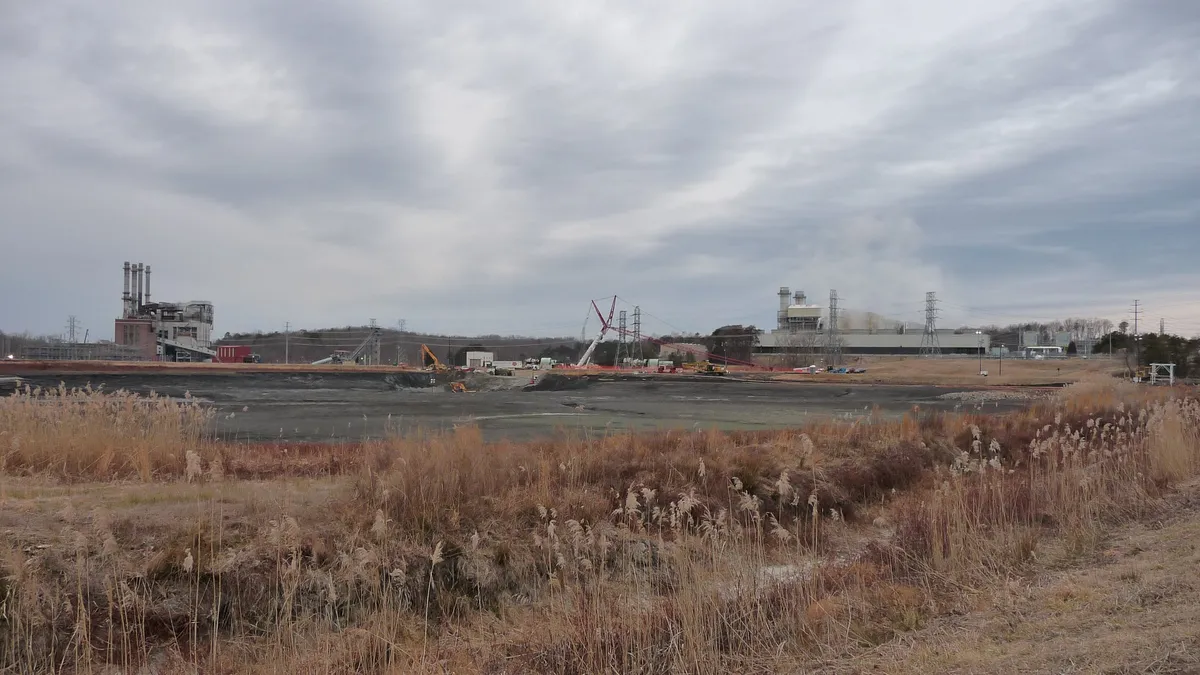Dive Brief:
- More than 90% of U.S. coal-fired power plants surveyed are leaking toxic metals into groundwater in violation of federal law, environmental groups said Thursday.
- Utilities and other power plant owners are manipulating groundwater monitoring data to make contaminated sites appear clean and to avoid cleaning them up, Environmental Integrity Project and Earthjustice said in a report.
- The report is a “gross mischaracterization” of the federal rule and how utilities are complying, an industry spokesman said.
Dive Insight:
Coal consumption by the power sector has declined, but the industry generates about 70 million tons of coal ash a year, according to the report, “Poisonous Coverup: The Widespread Failure of the Power Industry to Clean Up Coal Ash Dumps.”
Most coal ash produced by power plants over the past century has been dumped in unlined settling ponds and landfills, with minimal protections to prevent spills or leaking of hazardous chemicals by an industry looking to save money and avoid liability, advocates say.
“With billions of tons of poorly managed toxic waste all over the country you have obviously the potential for a big pollution problem,” Abel Russ, a lawyer at the Environmental Integrity Project, said at a news conference.
He cited a major slurry spill in Kingston, Tennessee, in 2008 when a dike ruptured. The U.S. Environmental Protection Agency established rules in 2014 for coal ash disposal, including requirements for recordkeeping and reporting and online posting of information.
The EPA rule also supports responsible recycling of coal combustion residuals, or CCRs, by distinguishing safe, beneficial use from disposal.
Lisa Evans, a lawyer at Earthjustice, said most coal plants are violating the law that requires toxic waste cleanup.
“Coal plants are polluting the nation’s water illegally and getting away with it,” she said. As many as 91% of regulated coal plants are poisoning the water with toxins “and doing little or nothing to restore it.”
Dan Chartier, executive director of the Utility Solid Waste Activities Group, said the report “represents a gross mischaracterization of both the CCR rule and industry's implementation of the rule.”
“Among other things, the report falsely asserts that facilities are ‘hiding’ contamination,” he said. “The fact is, regulated facilities must post their groundwater monitoring data to publicly available websites; indeed, the report relies on this data to make its assertions.”
The report accuses power companies of hiding evidence of contamination by using contaminated “background” wells as points of comparison, making it harder to find statistical evidence of coal ash pollution, leaving large parts of a disposal area unmonitored and using inappropriate statistical methods to conceal patterns of contamination.
The report also says power companies are illegally leaving coal ash in groundwater after closure and illegally failing to clean up contaminated groundwater.
Environmentalists say 265 of 292 plants, or 91% of facilities they evaluated, are contaminating groundwater in 43 states. Owners at nearly half of the plants deny responsibility and the remaining contaminated plants have submitted a plan detailing possible cleanup options. Only 38 have committed to a specific cleanup plan, according to the report.
Chartier said the CCR rule requires what needs to be done when groundwater monitoring finds a problem. An assessment of potential corrective measures must be conducted, he said. And a remedy is required that will protect human health and the environment, cleans up previous releases and controls further releases, he said.
Federal rules require that corrective measures will continue until groundwater protection standards are met and affected areas are cleaned up, Chartier said.
The EPA in July proposed denying requests from three Midwest coal-fired power plants to continue dumping coal ash in unlined surface impoundments. Earthjustice said then the EPA is interpreting and enforcing its coal ash rules for the first time since they were passed in 2015 and will set a precedent for more than 200 U.S. coal-fired power plants and the nearly 750 ponds and landfills where their ash is stored.















